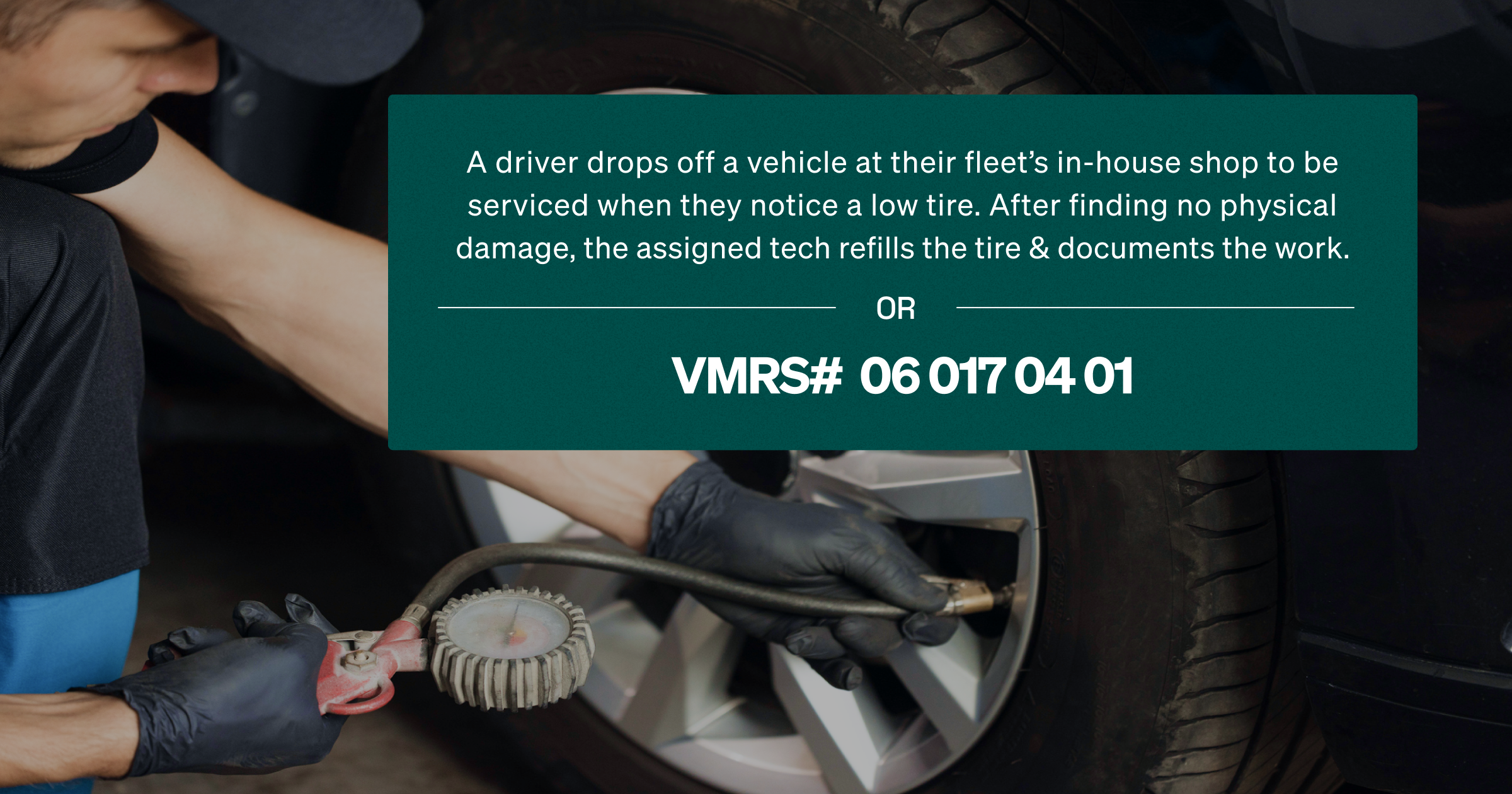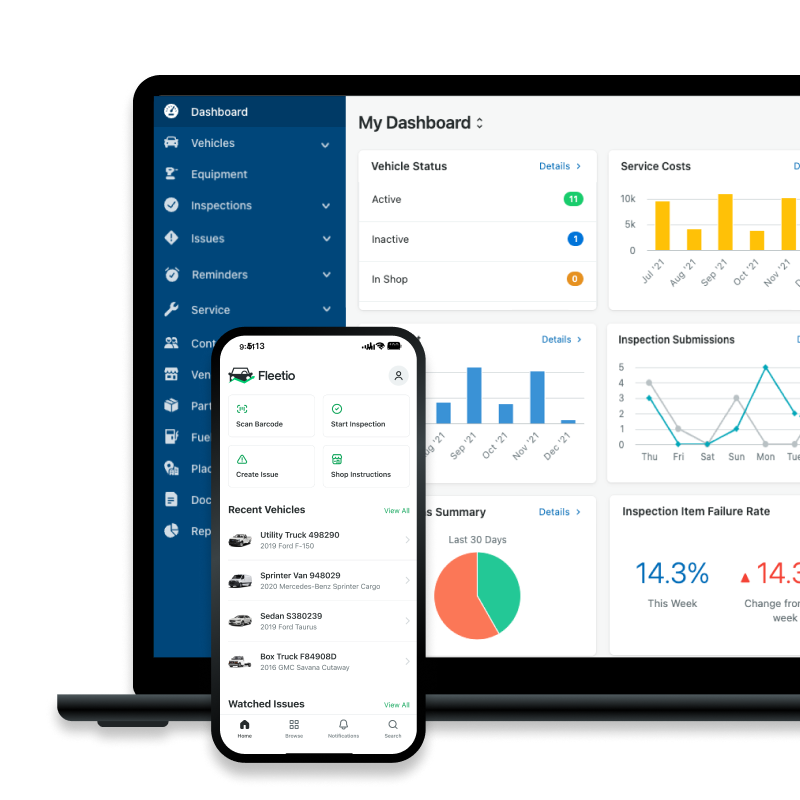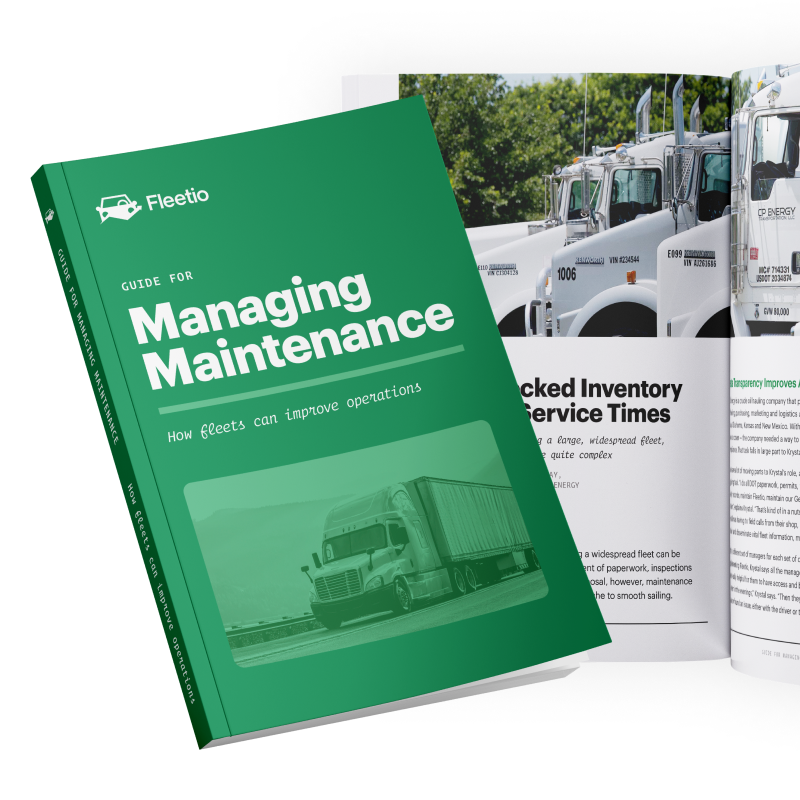How VMRS Streamlines Fleet Maintenance and Reporting
As a precision maintenance coding and reporting tool, VMRS provides a scalable, manageable analytics solution for fleets.
Apr 7, 2023 | Updated: Jul 25, 2025
9 min read

TL;DR: How VMRS fits into maintenance management
Vehicle Maintenance Reporting Standards (VMRS) is a universal coding system that standardizes how fleets categorize and track maintenance work. Created by the American Trucking Associations’ Technology & Maintenance Council, VMRS brings consistency to maintenance records across fleets, technicians, vendors and OEMs.
Here’s why fleets use it:
- Creates a shared language across teams and systems
- Improves maintenance visibility and reporting
- Helps identify high-cost repairs and recurring failures
- Enables better vendor and technician performance tracking
- Supports preventive maintenance planning
- Keeps fleets audit-ready and FMCSA compliant
VMRS transforms fragmented repair data into structured insights - helping fleets reduce downtime, control costs, and extend asset lifecycles.
Jump to a topic
VMRS: A Brief Overview
Vehicle Maintenance Reporting Standards (VMRS) is a systemized way to track, report and interpret fleet maintenance. Developed by the American Trucking Associations (ATA) in the 1970s, VMRS started as a tool for heavy-duty trucking fleets. Over time, its structured code system has been widely adopted by fleets operating light-, medium- and heavy-duty assets across industries including construction, transit, utilities and delivery.
Whether you're managing 25 assets or 2,500, VMRS helps bring consistency and insight to your maintenance data.
What is VMRS?
At its core, VMRS is a layered, numeric code system that classifies every part of a maintenance event — from the system involved (e.g. brakes, electrical) down to the specific reason for repair. Each event is documented using standardized codes drawn from a library of over 30 code keys.
We’ll get more in depth with code keys in a moment, but here’s a high-level overview of how VMRS works in practice:
- Code Key 33 indicates the system (e.g. cooling system)
- Code Key 34 drills down into the assembly (e.g. radiator)
- Code Key 35 identifies the component (e.g. radiator hose)
Additional code keys capture failure causes, work accomplished, technician info and more.
When used consistently, VMRS transforms service records from vague or inconsistent logs into data-rich documents that anyone in your organization — or your external vendors — can quickly interpret.
Why use VMRS? Key Benefits for Fleet Maintenance
Although developed for the trucking industry, VMRS has transformed over the years to reflect other industries’ use of the code system. VMRS(TM) Version 2.0 is the latest version and includes updates to accommodate construction, transit and off-highway industries. So why are so many fleets across so many industries using it? Efficiency.
1. A universal language across teams and vendors
One of VMRS’s biggest advantages is how it eliminates confusion. Whether a technician is entering work in a fleet maintenance platform or an accountant is reviewing service costs, VMRS codes provide clear, consistent terminology. This reduces miscommunication, especially in decentralized or multi-location operations. No more guessing what a handwritten “rad hse leak” means in a service log — VMRS removes ambiguity.
2. Cleaner, more searchable maintenance histories
Fleets often need to look back at an asset’s service history — either for audits, resale value or trend analysis. When those records are coded using VMRS, it’s easier to search, sort and analyze service data at the system, assembly and component level. Want to see how many alternators failed last year? VMRS makes it easy to filter that data across assets.
3. Optimized preventive maintenance strategies
Recurring issues — like frequent failures of a particular component — may not stand out in loosely written logs. With VMRS, those trends become much more obvious. Fleets can use this visibility to adjust PM intervals or swap out high-failure parts before they fail.
That means:
- Fewer breakdowns
- Lower total cost of ownership (TCO)
- Less reactive spend
4. Stronger cost control and service benchmarking
VMRS lets you break down maintenance spend in a granular way — by failure type, system and/or reason. With this level of detail, you can track PM vs. corrective repair costs, measure technician efficiency and identify high-cost asset types. That enables more informed budgeting and better technician and vendor performance tracking. The more specific your data, the more actionable your insights.
5. Faster, more accurate diagnostics
By requiring teams to classify failures and resolutions in a consistent way, VMRS can help technicians diagnose issues more quickly and accurately. Historical VMRS-coded records give teams insight into:
- What failed
- Why it failed
- How it was resolved
6. Simplified integration with digital fleet solutions
Digital fleet maintenance and management optimization platforms — including Fleetio — support VMRS integration. This allows you to: Automatically populate code keys during service logging Centralize and standardize your maintenance data Export VMRS-coded records for compliance or internal review
If your organization works with third-party shops or vendors that also use VMRS, this compatibility ensures data consistency no matter where service is performed.
Understanding VMRS Codes: A Numerical Breakdown
VMRS revolves mostly around a numerical system, although certain manufacturer brand or work accomplished codes will contain letters. Because vehicle technology continues to progress, VMRS codes are updated periodically by the ATA’s Technology and Maintenance Council (TMC) to stay current. This includes such updates as adding codes for electric vehicle (EV) powertrains. VMRS can even be scaled based on the information you want to include or exclude.
Let’s go ahead and break down one of the major code key segments—the parts-related codes:
- Code Key 31 — System: Code Key 31 is the first part in a 3-6-9 numerical grouping that specifies a vehicle component. Code Key 31 itself establishes the vehicle system in question; for example, code 001 equates to the air conditioning, heating and venting system, whereas code 013 corresponds to the braking system.
- Code Key 32 — Assembly: The second three numbers in the 3-6-9 grouping give the assembly information, or sub-system. This pinpoints more specifically the location within the system. For example: 013-001 specifies braking system-front brakes and drums, whereas 013-002 specifies braking system-rear brakes and drums.
- Code Key 33 — Component: The final set of data in this segment, or code key 33, is the component data. Not to be confused with a manufacturer’s part number, this three digit code is a universal identifier of parts, solutions, additives, lubes, oils and other miscellaneous components. For example, 043-001-053 indicates a diesel particulate filter.
These Code Keys can be used individually or together depending on the specificity desired in your vehicle maintenance reports. According to TMC, “VMRS can be used at any level, from total operating systems down to the individual part level. The level of coding used is entirely up to the user. No matter which level the user selects, the data collected can be compared directly to data collected by others at the same or higher VMRS coding level.” This provides a lot of flexibility when it comes to initial VMRS implementation, as well as data collection from third-party maintenance providers.
VMRS without the mess
Fleetio auto-tags VMRS codes so you don’t have to — no looking up codes, no hunting and pecking. Want to see how it works?
Catch a demoKnow Your Codes
On their own, the above codes offer very little information in the way of work performed or actual maintenance needs. Additional code keys indicate reasons for repair, work accomplished and more. These codes are especially useful for technicians, who are able to save time and more accurately report work orders, faults and repairs:
- Code Key 14 — Reason for Repair: Divided into the subcategories of maintenance, management decision and outside influence, Reason for Repair codes indicate why the asset has been sent to the shop (e.g. 01-breakdown, 22-conversion, 37-vandalism).
- Code Key 15 — Work Accomplished: Techs can enter this two-digit code to specify what work was completed (e.g. 03-replace new, 06-inspect, 14-install, 17-add fluids).
- Code Key 18 — Technician Failure: Techs can enter in a two-digit code corresponding to the reason the part in question failed, or the reason the tech believes it failed (e.g. 10-bent, 22-misaligned).
There are still other codes identifying additional information, such as asset vocation and body type, repair site, repair priority and more.

VMRS in the Fleetio Platform
Because it’s such a precision tool, VMRS maintenance coding and reporting is a part of Fleetio’s list of capabilities. This allows both existing VMRS users and those who wish to begin using VMRS to gain more precise, real-time insight into both in-house and third-party maintenance.
Fleetio’s VMRS solution is scalable to meet the needs of your fleet, so you get exactly the data you need without having to wade through extraneous information. Here are a few key features of our VMRS solution:
- Control over coding depth: As mentioned, VMRS is scalable, so you can control how much of the 3-6-9 Code Key segment your fleet utilizes. Additionally, with code visibility settings, you know only the codes you need are being used. This helps keep the implementation process smooth and keeps new VMRS users from getting overwhelmed.
- Third-party maintenance: Fleets outsourcing maintenance can run transactions through Fleetio’s Maintenance Shop Network, which will automatically transcribe the transactions into VMRS coding and categorize it accordingly.
- In-house maintenance: Fleets servicing assets in-house can select VMRS codes directly in Fleetio’s web or mobile interface through work orders.
- Reporting: VMRS reporting includes scheduled vs. unscheduled service, reason for repair and part information (system, assembly, component).
Breaking down maintenance costs by priority can help you identify where you can optimize processes for higher return on investment (ROI), while maintenance categorization by repair reason can help you identify specific cost accumulation areas, such as preventive maintenance or outside influence. By including VMRS in the Fleetio platform and fleet vehicle maintenance app, we aim to provide customers deeper maintenance tracking and analysis capabilities to improve overall uptime and fleet performance.
Maintenance Migraines? Take this.
Break free from maintenance headaches with our free Guide for Managing Maintenance. Covering in-house, third-party and mixed maintenance strategies, this complete resource offers industry-tested solutions to keep your fleet on the move and your costs in control.
Grab your copy now
Senior Fleet Content Specialist
As a Senior Fleet Content Specialist at Fleetio, Rachael Plant uses her near decade of industry experience to craft practical content aimed at helping fleet professionals tackle everyday challenges with confidence.
LinkedIn|View articles by Rachael PlantReady to get started?
Join thousands of satisfied customers using Fleetio
Questions? Call us at 1-800-975-5304

